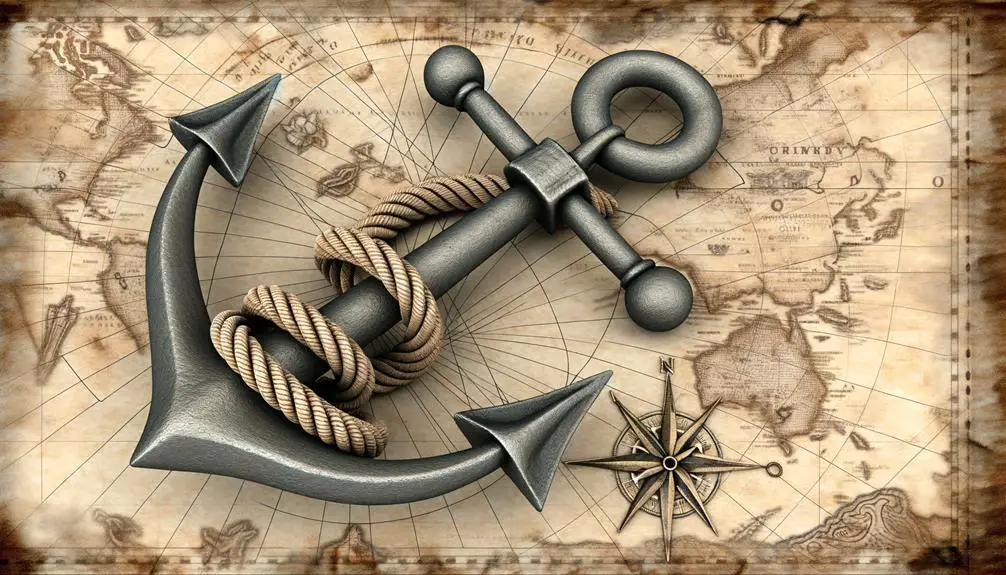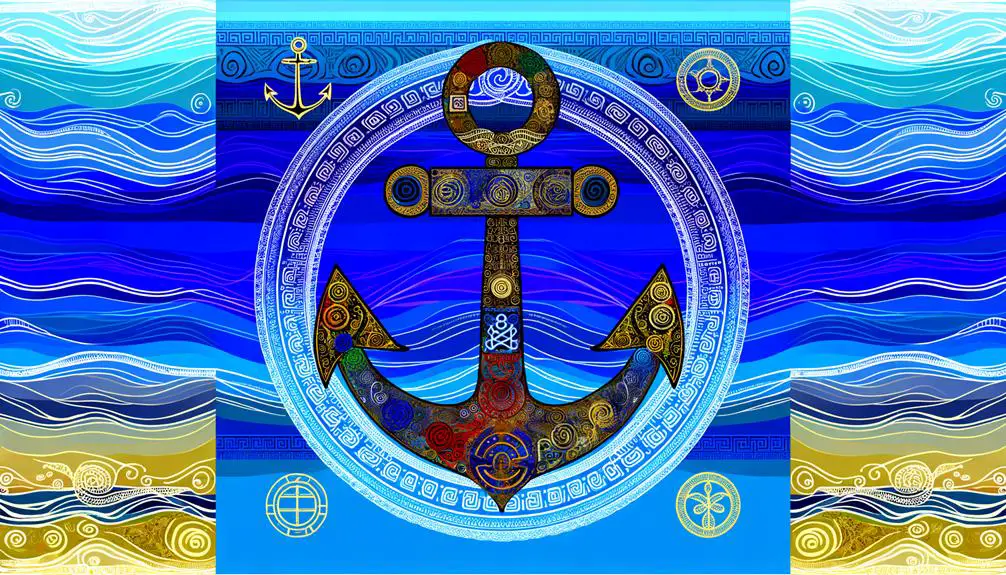What Does the Anchor Symbol’s Meaning Represent?
The anchor symbol, with origins in ancient Phoenician and Greek maritime practices, signifies stability and hope. Historically used for docking and navigation, its role evolved to symbolize security and steadfastness.
Early Christians adopted the anchor to represent hope and salvation, particularly during periods of persecution. In literature, anchors embody themes of perseverance and resilience.
Modern uses, including tattoos and corporate branding, extend this symbolism to personal narrative and reliability. Additionally, the anchor's psychological impact offers emotional grounding and resilience.
By exploring its multifaceted significance, one uncovers a rich tapestry of historical, cultural, and personal interpretations.

Key Takeaways
- The anchor symbolizes stability, hope, and steadfastness, originating from its critical role in maritime safety and navigation.
- In early Christianity, the anchor represented hope and salvation, often used covertly during times of persecution.
- Literature and tattoos use the anchor to denote stability, perseverance, and resilience, transcending its maritime origins.
- The anchor provides emotional resilience and cognitive grounding, fostering a sense of safety and tranquility.
- Corporate branding and interior design use the anchor to convey reliability, trust, and a nautical aesthetic.
Historical Origins

The historical origins of the anchor symbol can be traced back to ancient civilizations, where it served both practical maritime purposes and profound spiritual significance. Archaeological evidence indicates that anchors were used by the Phoenicians and Greeks as early as 2000 BCE. These early anchors, often carved from stone, were critical in stabilizing vessels.
Beyond their utilitarian function, anchors featured prominently in religious iconography. For instance, in early Christianity, the anchor symbolized hope and steadfastness, appearing in catacombs and on tombstones. This duality underscores the anchor's role as both a tangible tool and a metaphorical emblem.
Nautical Significance
Building upon its historical origins, the anchor's nautical significance is deeply intertwined with its practical application in ensuring the safety and stability of maritime vessels.
Functioning as an important piece of maritime equipment, the anchor prevents ships from drifting due to currents, tides, or wind. This stability is essential for safe docking, loading, and unloading, and for maintaining position in adverse weather conditions.
Historical records and modern maritime practices highlight the anchor's indispensable role in navigation and maritime safety. Naval architecture and engineering studies consistently underscore its efficacy, with innovations in anchor design optimizing holding power and reliability.
Therefore, the anchor remains a fundamental component in maritime operations, symbolizing security and steadfastness in the ever-changing marine environment.
Symbol of Hope

The anchor has long served as a potent symbol of hope, with its historical significance rooted in early Christianity where it represented safety and steadfastness amidst persecution.
In modern contexts, the anchor continues to symbolize hope and stability, often seen in literature, art, and personal adornments.
This enduring emblem bridges historical and contemporary interpretations, underscoring its timeless relevance.
Historical Significance
Historically, the anchor symbol has frequently been associated with hope, particularly during times of adversity and uncertainty. In the early Christian era, the anchor was clandestinely used as a symbol of steadfast faith and hope amidst persecution. Archaeological findings, such as inscriptions in Roman catacombs, reveal that early Christians adopted the anchor to signify hope in eternal life and divine salvation, mirroring Hebrews 6:19 which refers to hope as 'an anchor for the soul.'
Additionally, sailors have long viewed the anchor as a crucial emblem of safety and stability, offering reassurance during perilous voyages. This dual historical usage underscores the anchor's enduring representation of hope, resilience, and the human quest for security in the face of life's tempests.
Modern Interpretations
In contemporary contexts, the anchor symbol continues to epitomize hope, serving as both a personal emblem and a cultural motif that conveys stability and optimism amidst life's uncertainties.
This enduring relevance is evident in its widespread use in jewelry, tattoos, and fashion, often signaling resilience and steadfastness. Psychologically, the anchor acts as a metaphor for grounding oneself during turbulent times, fostering a sense of security.
In literature and media, it frequently appears as a symbol of perseverance and enduring faith. Recent studies in semiotics highlight how the anchor's imagery, rooted in maritime tradition, now transcends its origins, adapting to modern narratives of personal and collective fortitude.
Therefore, the anchor remains a potent, multifaceted icon of hope and resilience in contemporary society.
Religious Interpretations
Why does the anchor symbol hold such profound significance in various religious contexts, often representing hope, steadfastness, and salvation?
In Christianity, the anchor is frequently associated with Hebrews 6:19, which refers to hope as 'an anchor for the soul, firm and secure.' This metaphor underscores the stability and certainty that faith provides. Similarly, early Christians used the anchor as a covert symbol of their faith during periods of persecution, signifying hope and salvation through Christ.
In Buddhism, the anchor can symbolize the grounding of spiritual practice and the attainment of enlightenment. By offering tangible representations of intangible virtues, the anchor serves as a powerful religious emblem across different traditions, fostering a sense of security and eternal assurance.
Cultural Representations

The cultural significance of the anchor symbol extends beyond its functional maritime heritage, representing stability and hope within nautical communities.
This symbol also intersects with religious symbolism, where it has been interpreted as a representation of steadfast faith and salvation, particularly within Christian iconography.
Maritime Heritage Significance
Embodying a rich tapestry of cultural narratives, the anchor symbol has been deeply embedded in maritime heritage, serving as a potent emblem of stability, hope, and steadfastness across various seafaring communities. From ancient Phoenician sailors to modern naval forces, the anchor signifies a crucial connection to the sea, a source of livelihood and adventure.
Historical evidence suggests that anchors were not merely functional but also carried profound symbolic weight, often appearing in maritime artifacts and literature. These symbols provided psychological comfort to sailors facing the unpredictable nature of the ocean, reinforcing a sense of security and resilience.
Therefore, the anchor transcends its practical utility, becoming a cultural icon that underscores the intrinsic human need for stability amidst uncertainty.
Religious Symbolism Interpretations
In various religious settings, the anchor symbol has been interpreted as a representation of steadfast faith and eternal hope. Early Christians used the anchor as a covert symbol of their faith during periods of persecution, signifying Christ as the secure anchor of the soul. Within this framework, the anchor illustrated the believers' hope and stability amidst life's tumultuous seas.
| Religion | Interpretation | Symbolic Meaning |
|---|---|---|
| Christianity | Christ as the anchor | Steadfast faith, hope, and salvation |
| Hinduism | Stability in spiritual practice | Steadfastness and spiritual grounding |
| Buddhism | Anchor of mindfulness | Inner peace and enlightenment |
| Islam | Anchor of Tawakkul (trust in God) | Trust and reliance on divine will |
| Ancient Egypt | Symbol of eternal life and protection | Stability and protection in the afterlife |
Such interpretations underscore the anchor's universal appeal as a symbol of stability.
Artistic Depictions
Often rendered with intricate detail, artistic depictions of the anchor symbol reflect its historical and cultural significance across different mediums.
In visual arts, anchors have been depicted in paintings, sculptures, and jewelry, signifying stability and hope. For example, Renaissance artists integrated anchors into religious iconography, emphasizing spiritual steadfastness.
In maritime traditions, sailors' tattoos of anchors serve as personal emblems of safety and homecoming. Archaeological evidence from ancient seafaring civilizations shows anchors carved into pottery and tools, highlighting their functional and symbolic roles.
Contemporary graphic designers and illustrators continue to employ anchor motifs, adapting them to modern aesthetics while preserving their traditional meanings. These artistic representations underscore the anchor's enduring relevance across time and culture.
Literary Symbolism

Throughout literary history, the anchor symbol has been employed as a metaphor for stability, hope, and steadfastness, enriching narratives with deeper layers of meaning. This emblem often appears in works that explore themes of perseverance and resilience. For instance, in Herman Melville's "Moby-Dick," the anchor serves as a tangible representation of Ishmael's quest for equilibrium amidst chaos. Similarly, in the poetry of Emily Dickinson, anchors symbolize unwavering faith and enduring hope.
| Literary Work | Symbolic Interpretation |
|---|---|
| "Moby-Dick" | Stability amidst chaos |
| Emily Dickinson's Poems | Unwavering faith |
| "The Old Man and the Sea" | Perseverance and endurance |
| "The Odyssey" | Journey and return |
| "Robinson Crusoe" | Survival and resilience |
These examples demonstrate how the anchor motif weaves a rich tapestry of symbolic meaning in literary contexts.
Tattoos and Personal Meaning
While the anchor symbol's rich literary history underscores its thematic significance, its adoption in the world of tattoos offers a deeply personal and often layered interpretation of stability, hope, and resilience.
Tattoo enthusiasts frequently choose the anchor to symbolize a grounding force in their lives, whether that be a cherished relationship, personal strength, or a pivotal life event. Studies in cultural anthropology suggest that tattoos serve as modern amulets, with the anchor providing psychological anchorage amid life's uncertainties.
Additionally, the symbol's maritime origins resonate with individuals who have a deep connection to the sea or maritime professions. Consequently, the anchor tattoo transcends its aesthetic appeal, functioning as a potent emblem of personal narrative and existential anchoring.
Modern Uses

The anchor symbol has evolved to find myriad applications in contemporary contexts, reflecting its enduring relevance and adaptability.
In corporate branding, companies utilize the anchor to convey stability and reliability, key attributes in financial and maritime industries.
Fashion designers incorporate the symbol for its classic and nautical associations, appealing to both tradition and modern aesthetics.
Moreover, digital platforms and social media have adopted the anchor emoji to signify steadfastness and grounding in personal communication.
Evidence from marketing studies suggests the anchor's visual appeal enhances consumer trust.
Its versatility is also evident in interior design, where it is often used to create serene, coastal-inspired spaces.
These modern uses underscore the symbol's capacity to maintain significance across diverse fields.
Psychological Impact
The anchor symbol exerts a notable psychological impact by providing a sense of stability. This can enhance emotional resilience and foster a feeling of symbolic security. Research indicates that individuals who identify with symbols of stability often exhibit greater mental fortitude in times of uncertainty.
Consequently, the anchor serves as a powerful emblem for personal grounding and emotional strength.
Sense of Stability
Anchors, as symbols, evoke a profound sense of psychological stability by representing steadfastness and reliability amidst the uncertainties of life. This symbolic meaning can be analyzed through various dimensions:
| Aspect | Description |
|---|---|
| Steadfastness | Anchors ground us, providing a sense of security. |
| Reliability | They signify dependability in challenging times. |
| Permanence | Anchors are unyielding, fostering a sense of calm. |
Studies in psychology suggest that symbols like anchors can offer mental reassurance, reinforcing feelings of stability in turbulent circumstances. This cognitive association aids in reducing anxiety and enhancing mental fortitude. The anchor's symbolism therefore becomes a mental anchor, grounding individuals and helping them navigate life's uncertainties with greater confidence and serenity. This inherent stability is essential in maintaining psychological well-being.
Emotional Resilience
Building on the sense of stability provided by anchors, their symbolic power extends further by fostering emotional resilience, offering individuals psychological tools to weather life's emotional storms. The anchor symbol aids in emotional resilience through several mechanisms:
- Grounding Effect: Anchors remind individuals of their core values and beliefs, helping them stay grounded during turbulent times.
- Cognitive Reframing: The image of an anchor encourages a mental shift from chaos to stability, fostering positive coping strategies.
- Stress Reduction: Visualizing an anchor can have a calming effect, reducing anxiety and promoting emotional equilibrium.
These mechanisms are supported by psychological studies demonstrating that symbols with personal significance can bolster emotional resilience, providing a sense of control and stability amidst uncertainty.
Symbolic Security
Symbolic security, derived from the anchor symbol, plays a vital psychological role by providing individuals with a sense of safety and stability. This emblem is historically linked to seafaring, where anchors were essential for securing vessels. Psychologically, it translates to grounding and reassurance, often used in therapeutic settings to evoke feelings of calm and steadfastness. Evidence suggests that visual symbols can greatly impact mental well-being by reducing anxiety and promoting emotional equilibrium.
| Aspect | Psychological Impact | Evidence-Based Findings |
|---|---|---|
| Safety | Provides a sense of security | Reduces anxiety levels |
| Stability | Enhances emotional grounding | Promotes emotional equilibrium |
| Resilience | Boosts mental resilience | Facilitates coping mechanisms |
| Tranquility | Evokes calmness | Used in therapeutic settings for relaxation |
Understanding its psychological impact can improve the use of symbols in mental health practices.
Conclusion
Coincidentally, the anchor symbol, with its rich tapestry of historical origins, nautical significance, and diverse interpretations, continues to evoke a powerful sense of stability and hope across various contexts.
From religious symbolism to cultural representations, literary allusions, tattoos, and modern applications, the anchor remains an enduring emblem.
Evidence suggests that its psychological impact is rooted in its universal appeal as a symbol of steadfastness and resilience, transcending time and cultural boundaries to remain relevant in contemporary society.





